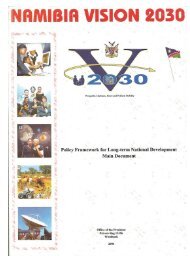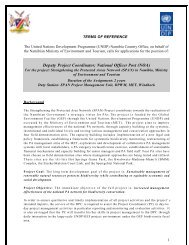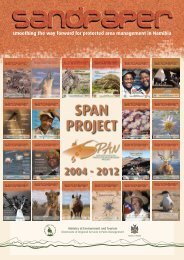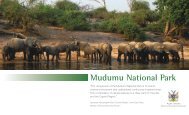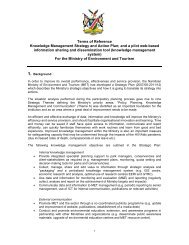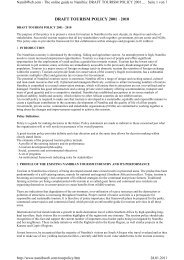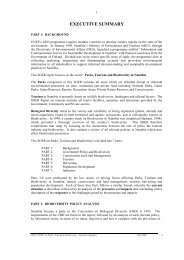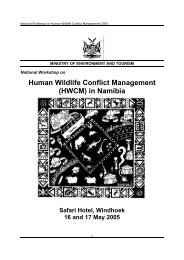Etosha: the Human Footprint - Ministry of Environment and Tourism
Etosha: the Human Footprint - Ministry of Environment and Tourism
Etosha: the Human Footprint - Ministry of Environment and Tourism
You also want an ePaper? Increase the reach of your titles
YUMPU automatically turns print PDFs into web optimized ePapers that Google loves.
farml<strong>and</strong> <strong>and</strong> <strong>the</strong> effects <strong>of</strong> anthrax, drought <strong>and</strong> predation. Concern over <strong>the</strong> viability <strong>of</strong> <strong>the</strong>se<br />
populations prompted <strong>the</strong> initiation <strong>of</strong> a twice-yearly monitoring program <strong>of</strong> group composition<br />
for Burchell‟s zebra, wildebeest <strong>and</strong> springbok. Using <strong>the</strong>se data from 1995-2006, we re-evaluate<br />
<strong>the</strong> dynamics <strong>of</strong> <strong>the</strong>se populations to assess how environmental variability affects juvenile<br />
recruitment <strong>and</strong> survival. <strong>Environment</strong>al variability is quantified using measures <strong>of</strong> rainfall <strong>and</strong><br />
<strong>the</strong> Normalized Difference Vegetation Index (NDVI), proxies for forage abundance <strong>and</strong><br />
vegetation growing season length.<br />
Martina Trinkel<br />
Spotted hyenas in <strong>Etosha</strong> National Park, Namibia<br />
Spotted hyena social <strong>and</strong> spatial organisation <strong>and</strong> <strong>the</strong> interaction between hyenas <strong>and</strong> lions are<br />
described. Clan size <strong>and</strong> structure differed between Central <strong>and</strong> Eastern <strong>Etosha</strong>. The study clan in<br />
Central <strong>Etosha</strong> comprised 8 adult hyenas, while <strong>the</strong> two study clans in Eastern <strong>Etosha</strong> comprised<br />
15 to 17 adults each. Reproductive success <strong>and</strong> survival rate were higher for hyenas in Eastern<br />
<strong>Etosha</strong>. The spatial organization <strong>of</strong> <strong>the</strong> clan in Central <strong>Etosha</strong> was investigated during <strong>the</strong> dry <strong>and</strong><br />
<strong>the</strong> wet season. The clan occupied a home range <strong>of</strong> 160 km2 in <strong>the</strong> dry season <strong>and</strong> 320 km2 in <strong>the</strong><br />
wet season. The dry season home range contained low densities (1 animal/km2) <strong>of</strong> resident<br />
herbivores, such as gemsbok, kudu, giraffe, steenbok <strong>and</strong> ostrich. The migratory species are <strong>the</strong><br />
more important prey (12 animals/km2) with springbok, zebra <strong>and</strong> wildebeest. During <strong>the</strong> wet<br />
season, <strong>the</strong> migratory herbivores migrated to northwest <strong>and</strong> left <strong>the</strong> area <strong>of</strong> <strong>the</strong> dry-season home<br />
range <strong>of</strong> <strong>the</strong> hyena clan. There existed a strong relationship between <strong>the</strong> abundance <strong>of</strong> hyenas<br />
within <strong>the</strong>ir dry <strong>and</strong> wet season home ranges regarding <strong>the</strong> abundance <strong>of</strong> <strong>the</strong>ir prey. In Central<br />
<strong>and</strong> Eastern <strong>Etosha</strong>, hyenas were unable to prevent kleptoparasitism by lions <strong>and</strong> failed to acquire<br />
kills from lions. The reasons were <strong>the</strong> small ratio <strong>of</strong> hyenas to female <strong>and</strong> sub-adult lions at kills<br />
<strong>and</strong> <strong>the</strong> presence <strong>of</strong> adult male lions. Because <strong>of</strong> <strong>the</strong> hyenas small clan sizes <strong>and</strong> large territories<br />
<strong>the</strong>y seemed to be unable to recruit sufficient clan members to take over lion kills or deter lions<br />
from <strong>the</strong>ir own kills. In <strong>Etosha</strong>, 71% <strong>of</strong> hyena mortality was due to lions.<br />
Caitlin O'Connell-Rodwell<br />
Multi-modal communication, relationships <strong>and</strong> hormones in <strong>the</strong> African elephant:<br />
Applications for conservation<br />
The structure <strong>of</strong> African elephant society is primarily matriarchal in nature, where dominant<br />
female elephants make decisions for <strong>the</strong> herd as a whole with regard to safety, movements,<br />
resource choices <strong>and</strong> affiliations. Aspects <strong>of</strong> elephant society that contribute to survival will be<br />
discussed in <strong>the</strong> context <strong>of</strong> long distance communication, local environmental <strong>and</strong> social<br />
pressures, as well as character <strong>of</strong> individual herd members. New findings about elephant bull<br />
society will be reviewed, highlighting <strong>the</strong> importance <strong>of</strong> bonding <strong>and</strong> mentoring <strong>and</strong> addressing<br />
potential applications to conservation.<br />
Eline Lorenzen<br />
Using genetic data to investigate potential hybridization between black-faced <strong>and</strong> common<br />
impala in <strong>Etosha</strong> National Park<br />
Nuclear genetic markers were used to determine if, <strong>and</strong> to what extent, hybridization occurs<br />
between <strong>the</strong> vulnerable endemic black-faced impala <strong>and</strong> introduced common impala in <strong>Etosha</strong>.<br />
No evidence <strong>of</strong> interbreeding between <strong>the</strong> two subspecies was found.<br />
Session 4. <strong>Etosha</strong> <strong>and</strong> Beyond<br />
Mutjinda Katjiua<br />
Pastoralists' perceptions <strong>and</strong> realities <strong>of</strong> vegetation change <strong>and</strong> browse consumption in <strong>the</strong><br />
nor<strong>the</strong>rn Kalahari, Namibia<br />
Pastoral production around artificial watering points in semi-arid environments affects <strong>the</strong><br />
density <strong>and</strong> composition <strong>of</strong> plant communities. In <strong>the</strong> Kalahari desert <strong>of</strong> southwestern Africa,<br />
bush encroachment is <strong>of</strong>ten regarded as <strong>the</strong> major form <strong>of</strong> l<strong>and</strong> degradation resulting from<br />
6



